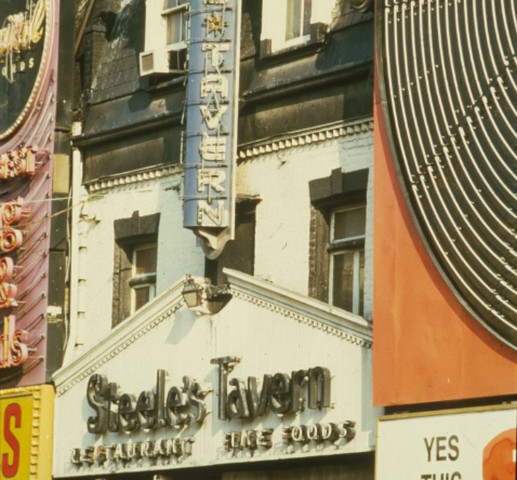
The Heart of Music City: Zanzibar & Steele’s Tavern
Steele’s Tavern
Steele’s Tavern sign, Toronto, 1977-1983. City of Toronto Archives, Fonds 200, Series 1465, File 612, Item 7.
Gordon Lightfoot performs at an event for his new single, “I’m Not Sayin’” at Steele’s Tavern, Toronto, ca. 1960s. City of Toronto Archives, Fonds 1257, Series 1057, Item 3405.
The Zanzibar Tavern long after it had stopped being a live music venue, Toronto, 1986-1992. Courtesy City of Toronto Archives, Fonds 200, Series 1465, File 618, Item 41.
View of Zanzibar during Heritage Toronto’s Yonge street: The Heart of Music City walking tour, 2019.
Yonge Street’s folk music home
Steele’s Tavern was opened in1936 by Steele Basil, and in 1948, it was one of the first establishments in Toronto to be licensed to serve cocktails.
By the early 1950s, Steele’s Tavern offered an international mix of live music acts, from Venetian accordion to Hawaiian melodies. In 1963, a renovation to the Tavern’s upstairs Venetian Room allowed for bigger musical acts to perform. Almost immediately, Steele’s Tavern’s live music focused on folk music, largely because, in owner Basil Steele’s words, “all of the other bars had country and western, rock ‘n’ roll, or were topless.”
One of the first acts to perform in the newly expanded venue was the American folk trio the Spokesmen. Fresh from their performance at the Mariposa Folk Festival, the group played songs like “The Dawn of Correction” to Tavern patrons, with lyrics that touched on current events like the Civil Rights Movement, the Space Race, and the Cold War.
Gordon Lightfoot’s early stomping grounds
In February 1964, a young Gordon Lightfoot made his debut at the Venetian Room. Singing his own songs and playing the guitar, Lightfoot found a warm reception from the Tavern’s folk music crowd. Canadian folk duo Ian and Sylvia Tyson caught Lightfoot’s Tavern performance and recommended he sign with their manager, Albert Grossman.
Grossman, who also happened to be Bob Dylan’s manager, helped Lightfoot develop his folk career. A year later, the Tavern, along with help from next door’s Sam Sniderman, owner of Sam the Record Man, threw Lightfoot a party to celebrate his first single on Warner Music, “I’m Not Sayin’.” Owner Steele Basil retired in 1974 and closed the Tavern. Sam the Record Man soon bought the location and expanded into the former Tavern space.
Zanzibar
Club Zanzibar, formerly known as the Zanzibar Tavern, is one of the few remaining relics of the original Yonge Street strip. First known as the Rosticceria Restaurant in the 1940s, a name change in 1950 saw the birth of the Zanzibar Tavern.Once a family restaurant, the Zanzibar turned increasingly to cocktails and live entertainment. By the late 1950s, the Zanzibar hosted bands such as Tommy Danton and the Echoes, who played early rock and roll hits like “Rocket to the Moon.”
Go-go dancers and blues musicians
By 1965, the Zanzibar Tavern boasted a large dance floor, continuous live entertainment, and go-go dancers performing under psychedelic mutli-coloured neon lights and spinning disco balls. Live music at the Zanzibar also changed to match the new look, featuring bands like the Georgian IV, originally from Parry Sound. The band changed its name to Chimo! in 1969 and opened for such acts as the Grateful Dead, Janice Joplin, and the Band.
An unusual bar snack
According to Ontario law, food had to be served with any alcoholic beverage. To comply strictly to the letter of the law,the Zanzibar was known to have a single circulating ham sandwich that would accompany any ordered drink. Never eaten, the sandwich would simply sit on the table beside the drink until needed by another thirsty patron.The sandwich may have not entirely fooled the authorities, who suspended the Zanzibar’s liquor license in March 1963 for “repeated service of liquor without meals.”
But people came to the Zanzibar for more than just a drink and a sandwich. Leading the house band for over a decade was singer and organist Bobby Dean Blackburn. Blackburn’s many connections in the music world made the Zanzibar a home away from home for many a travelling musician. Anyone from Rick James to Buddy Miles stopped in to play a set with Blackburn. After his work at the Zanzibar, Blackburn recorded his first album at the age of 69 in 2010, which includes a cover of the 1957 blues classic, “Mojo”.
In the early 1970s, the Zanzibar moved away from live music to burlesque entertainment, renaming itself twice, first as the Zanzibar Circus Tavern and later Club Zanzibar.

